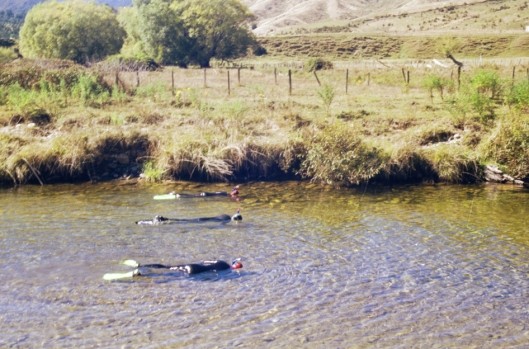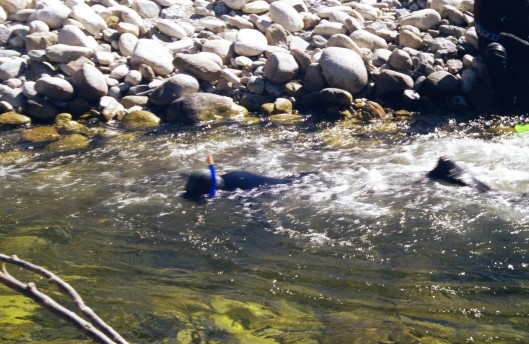Drift diving - by Grant Irvine, RSNZ Teaching Fellow
Drift diving is a term that is often used when ascertaining trout numbers in rivers. Just what goes on and how it is carried out is not so well known.
Essentially, drift diving is a method by which a group of divers count trout in medium to large clear-water rivers.
In many Fish and Game regions drift diving results provide the data on which management decisions are based. While those who conduct such dives would be the first to admit that this is not an 'exact science', when managed correctly, it does provide a trend over years.
How is it carried out?
Divers equipped with wetsuit, fins, mask, snorkel, gloves and sometimes weight belt, drift in unison down a pre-selected stretch of river (usually 1-1.5 km). On large rivers where a more detailed picture is needed a number of randomly chosen sites may be picked.
Visibility
Good visibility is crucial to the success of any dive. 'If you can't see, you can't count.'
Prior to diving, the underwater visibility is measured. This is obtained by a diver who measures the distance at which a 20 cm black disc just disappears from view. At this point the tape measure is read and that particular 'stretch' has a visibility reading. NIWA and regional councils regularly take black disc readings throughout New Zealand as part of national and regional water quality monitoring.
On a national basis, river waters with a black disc visibility of about 7 metres or more are in the top 5%. Drift diving is best undertaken in rivers with a visibility of about 4 m or more. Some Nelson rivers have black disc visibilities of up to 25 m, while the Waikoropupu Springs in Golden Bay has a visibility of 62 m.
As the divers drift with the current they attempt to stay in a line, perpendicular to the bank. Missing trout or double counting can occur if the line is not maintained. Trout are counted as they pass underneath or around a diver. It is important for divers not to bunch and to remain an equal distance apart across the width of the river. Visual contact must be maintained between adjacent divers.
The number of divers needed for a river is dependent on the width of the river, the water velocity, amount of fish cover and the visibility.

Drift diving a river
Effective communication (sign language or brief comments) is needed in order to decide who counts which fish.
As well as counting fish, divers classify the fish they see by species (rainbow or brown trout and sometimes salmon) and size. Size classes most commonly used are: Small - < 200 mm, Medium - 200 - 400 mm, and Large - > 400 mm.
In order to increase accuracy the team may stop at the end of a run to 'download' numbers and sizes and to regroup to maintain that all important line. The team leader records this information on 'wet note' paper
In deep pools it is important to look closely as fish will take cover, often in very deep water. 'Duck diving' to the bottom is often necessary for coverage of these areas.
In rivers where there is abundant in-stream cover, fish have many places to hide from these 'large, black one eyed intruders'. Even greater care is needed to look for fish in these places.
As the velocity of the river across its width is not uniform, divers need to be acutely aware of their speed in relation to the rest of the team. There are a number of ways in which divers can 'keep the line' in these circumstances. Those swimming the edge have the difficulty of trying to move faster by fin-kicking in shallow water to keep up, while also looking closely amongst fish cover like willows and undercut banks. Those in mid-stream often have to slow down or stop.
In braided rivers all stems of the river need to be covered.
In narrow runs it may not be possible for all divers to float down together and get an accurate count. In such situations two to three of the more experienced divers should go first and do the count with the rest going down for the ride.
It is important when carrying out more than one dive on the same river to take a visibility reading at each site as there can be considerable differences in clarity, especially downstream after tributaries have entered the main stem.
A vehicle needs to be located at the 'pullout point' in order to save a long trek back.
Safety Considerations
Any activity carried out in water needs to be taken seriously and all necessary steps taken to ensure the safety of all. Drift diving, due to its very nature deserves close attention.
Divers should have a dive course accreditation and all the gear mentioned earlier.
In the water - Rapids
- When floating down rapids keep your hands out in front (headfirst) to protect your face and assist with maneuverability.
- Use your hands to push up over and around rocks.
- Go with the flow. Like childbirth, once you're in it you can't stop until you get out the other side. Trying to fight the current or stop will often create more problems.
- Try and maintain a body position parallel with the current.
- Keep a balance between underwater observation of obstacles and an above water view of upcoming potential dangers and safest routes.

Other Dangers
- Overhanging tree branches and submerged or semi-submerged trees.
- Wire
- Warratahs facing upstream
- Waterfalls of any size!!!!!!!!
These main dangers can be countered by being vigilant both above and below the water surface. As you dive a stretch of river more than once you build up 'local knowledge' and this is useful for following dives. You need to be aware that due to flooding, rivers can change over the course of a year meaning that potential hazards may have been removed or arisen in new places.
Weaknesses
As with any method of ascertaining the population of a species, drift diving has its drawbacks and limitations.
- Diver error - remembering or more importantly, forgetting, just how many fish were seen. This is not helped by having to remember the three size classes and in some cases counting different coloured tagged fish as well.
- Accuracy in counting schools of fish (up to 100) which swim by very quickly
- Not seeing fish due to
the
- diver looking in the other direction- fish hiding in cover (the extent of this will be river dependent)
- water being too shallow to see fish
- a rapid being very fast and not giving the diver enough time to see
- bubbles in fast flowing rapids makes visibility hard
- inability of a diver to see fish - poor spotting - lack of experience
- poor water clarity affecting distance that can be seen
- a buildup of algae that in shallow water can be disturbed, with this drifting down in front of the diver hindering good visibility
- when your head is out of the water checking what's ahead and where you are in relation to other divers, fish can slip past
- too few divers for the size of the river allowing fish to swim past without being seen
- not getting down deep enough in pools
- Double counting of fish by divers.
- Having to continually train up new divers who are inexperienced.
- This method can only be used successfully in clear-water streams and rivers.
- Comparisons of trout numbers between rivers using drift diving would be unwise as there are many factors such as cover, water clarity, and diver numbers that affect accuracy.
- With all these factors taken in to consideration just how accurate is the information gained?
Refer ("Assessing the accuracy of drift dive estimates of brown trout abundance in two New Zealand rivers: a mark-resighting study) Roger G. Young, John W. Hayes New Zealand Journal of Marine and Freshwater Research -Volume 35 Number 2 June 2001.
Strengths
Compared to other techniques it is a relatively cheap and successful measure of trout populations.
Drift diving does not set out to give an 'exact 'number of fish for a particular stretch of river. It does, however, give an indication of numbers in three size groups. This information can not only solve some rather heated debates over the relative health of trout stocks, it can make very interesting reading when compared with dives from preceding years.
If monitoring changes in a trout population in a river over time is the main aim, then any changes in counts can be assumed to be relevant providing the factors affecting drift dive accuracy remain the same. e.g. Same reaches used, similar visibility, same number of divers etc.
Data gained can be compared with fish observations in the river, the effects of flooding, poor spawning season or vice versa. After a very good spawning season it would be expected that this would translate to good numbers of 'smalls' the following year. The 'bulge' would hopefully be mirrored in the dive results of subsequent years.
At present there is no other method as successful as, and less intrusive than drift diving to ascertain trout populations!!!!
Other Advantages of Drift Diving
Entering the trout's world allows you to see a number of important features. Firstly, you get a much better idea of the importance of cover. It becomes clear why trout take up feeding positions where they do. It also enables you to feel the shear factors which enable feeding trout to stay close to the faster flowing water, with its "conveyer belt" of food, while avoiding expending too much energy behind or in front of rocks.
Drift diving may reveal low numbers of fish in total or within a particular size class and being in the water offers greater opportunity to discover reasons for such a decline.
Another advantage with drift diving is being able to see the aquatic life that inhabits the stream bed. The abundance of certain species gives an indication of trout diet. This is not only of interest to biologists but handy for the keen angler.
Trout Reaction
It is interesting to note the various reactions of brown and rainbow trout and different sizes to the presence of divers.
Large brown trout will often seek cover or remain motionless on the bottom unless approached too closely.
Smaller brown trout often move to the tail of the pool, where they form schools before darting back upstream, underneath or around drifting divers.
Undisturbed rainbows can often be seen swimming in the main water column. Like small browns, rainbows will also 'school' at the tail of pools before making a mad dash for the security of deeper water. What is intriguing is that trout are reluctant to leave their pool even when confronted with a number of divers.
They are similar to sheep, in that when they are cornered they mill about before looking for the safest escape route.
Conclusion
Drift diving is the only sampling method available to quickly determine fish numbers in medium to large rivers.
Provided that proper procedures are followed and that the conditions are suitable, drift diving as a technique is less intrusive than other methods. It is also relatively quick, cost effective and efficient.
If you get the chance I recommend you give it a go with an experienced team as it will open up a whole new world you didn't know existed and increase your understanding of trout in their natural environment.